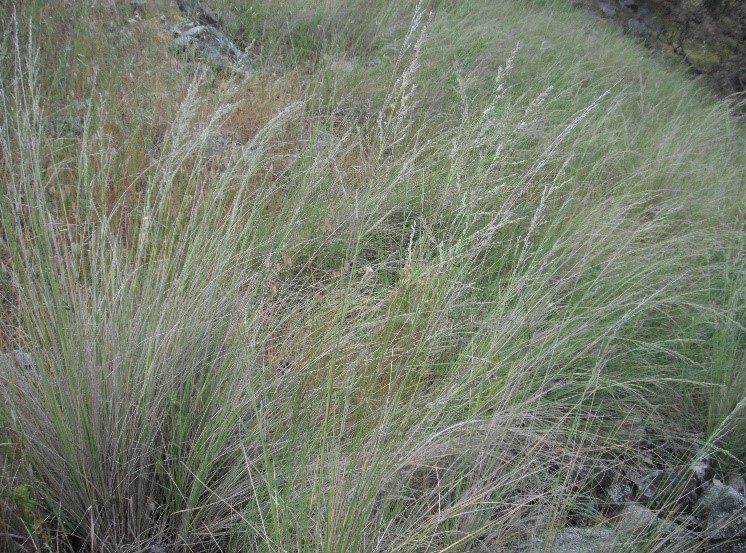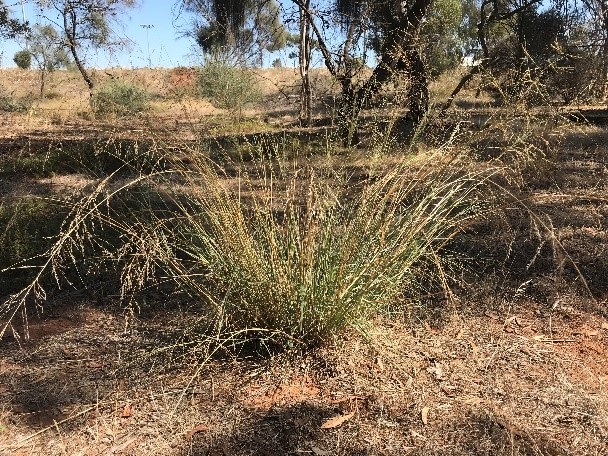African lovegrass – Building Regional Strength for National Impact Program
Do you have African lovegrass on your property? This tussock-forming and summer active grass generates thousands of seeds each year meaning it can quickly spread to take over large areas, contaminating produce and reducing the productivity of land. African lovegrass has minimal nutritional value for grazing, can suppress preferred pasture species and poses a significant fire hazard.
Getting African lovegrass under control and ideally eradicating it will benefit you and the environment in the long term. African lovegrass is also a declared weed under the Landscape South Australia Act 2019 and must be controlled by landholders.
In 2025-26, the Department of Primary Industries and Regions (PIRSA), Landscapes Hills and Fleurieu and Green Adelaide are partnering to deliver a State and Commonwealth Government funded program to help landholders across both regions control African lovegrass by providing free contractor visits for mapping and control work.
This landscape-scale approach provides hands-on support to manage African lovegrass infestations, reducing the economic burden of controlling the declared weed.
The African lovegrass Control Program:
- Is free to join across the Hills and Fleurieu and Green Adelaide regions.
- Is easy to sign up to.
- Supports you to take control and manage African lovegrass infestations, meeting your responsibility to control African lovegrass on your property under the Landscape South Australia Act 2019.
Register your interest now at the PIRSA website, applications open until allocation is exhausted.
Ideally you should plan for a multi-year control program and use this project to start your control. Landscapes Hills and Fleurieu have developed a comprehensive guide and action plan that can help with your planning, Five steps to effective weed control and Action Plan.
Resources will be allocated dependent on contractor availability to ensure as many landholders as possible receive assistance within the spraying season. Signing up does not guarantee involvement in the program.
Applications open until allocation is exhausted.
If you would like more information, please contact:
Simon Roos-Freeman, Weed Control Coordinator, PIRSA
T: 08 7133 8950
M: 0408 367 556
E: simon.roos-freeman@sa.gov.au
The African lovegrass Control Program is funded by the regional landscape levy, the Commonwealth Government and the Government of South Australia through the African lovegrass – Building Regional Strength for National Impact Program.
African lovegrass is a summer growing, drought tolerant, hardy, perennial (lives on year to year) grass that invades pasture and native vegetation.
About African lovegrass
Description
African lovegrass, also commonly known as weeping lovegrass, forms large, unpalatable perennial tussocks (grouped grasses) that grow between 30 and 120 cm high. Leaves are up to 30 cm long and narrow (3 mm wide) with rolled margins. Leaf colour varies from dark green to blue-green.
The flower stems are slender, erect and sometimes arching giving them the “weeping” look. The flower heads form an open panicle (cluster) 6 to 30 cm long with a dark grey-green colour. Ripe seed are present from January to March. Seeds germinate in autumn or spring and are viable for 1 to 5 years.
Similar species
African lovegrass is one of many Eragrostis species, both introduced and native. It can also look similar to other native tussock grasses like Poa and Austrostipa species. Green Adelaide can assist with identification if needed.
Impacts
African lovegrass is highly invasive in grasslands but also in heathlands, woodlands, forests, and riverine environments. It is capable of dominating ground flora causing major displacement of native species and productive plants in pastures.
Considered an early coloniser in disturbed sites particularly along roadsides, African lovegrass can move into pasture areas quickly. It recovers rapidly after fire, is drought tolerant, and forms large swards that increase fire intensity resulting in loss of native flora and fauna.
Mature African lovegrass is unpalatable to stock, which results in selective grazing that reduces desirable pasture species and carrying capacity but favours the weed, increasing size of infestations. If unchecked, it can spread and form pure, dense infestations.

Distribution
African lovegrass was introduced from east Africa as a pasture plant and is widely distributed in Australia. It requires an annual rainfall of at least 400 mm and can be found on a range of soil types.
In South Australia, African lovegrass is mainly restricted to the sides of major roads and some grazing properties. It is present on highways and main roads around Adelaide and some dryland reserves.
Seeds can be spread by wind, water, animals, machinery, vehicles and in contaminated hay and soil, assisting with the establishment of new infestations. Slashing is the main means of spread throughout the Adelaide area.
Control
African lovegrass is a declared weed under the Landscape South Australia Act 2019. The sale of African lovegrass or contaminated goods; and its movement on a public road are prohibited. It is the responsibility of the land owner to control these plants on their property.
Green Adelaide encourages the control of African lovegrass where there is a risk to biodiversity assets and agricultural enterprises.
The leafier and less weedy cultivar for pastures, Eragrostis curvula ‘consol’, is excluded from the declaration.
Control methods
Hygiene
To prevent the spread of African lovegrass, avoid working in infested areas except for control work, and do not remove seeds or plants from infested areas, unless disposing of appropriately. Any control work should be undertaken prior to seed set.
Do not buy or sell contaminated fodder and always decontaminate stock prior to moving. Thoroughly brush down equipment, clothing, machinery and vehicles when leaving an infested area.
Mechanical
Grubbing or digging out of plants is effective for small isolated populations and can be done any time of the year. Soil disturbance in infested areas should be minimised to avoid creating opportunities for African lovegrass seed to germinate.
Repeated mowing prior to seeding can reduce seed production.

Controlled grazing
Young plants are nutritious and are readily grazed by stock thereby reducing plant density and seed production. As plants mature they become unpalatable to stock and they will then graze on competing pasture species. Manage grazing so plants cannot grow to a stage where they become unpalatable.
Chemical
Foliar herbicides (weedkillers) can be spot sprayed on individual plants present in areas of native vegetation or on roadsides during active growth. Chemical treatment is most effective on larger infestations when combined with pre-mowing and then spraying of regrowth. Avoid spraying native plants.
For larger infestations where no native grasses are at risk, soil residual herbicides are effective when applied prior to or at early active growth. This can significantly reduce follow-up control because it suppresses the growth of new seedlings. Sufficient rain is required to wash the herbicide into the root zone but not too much to wash it away.
For advice on chemical options please refer to Controlling declared weeds in SA.